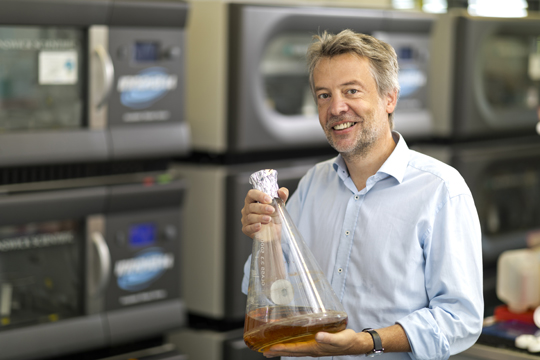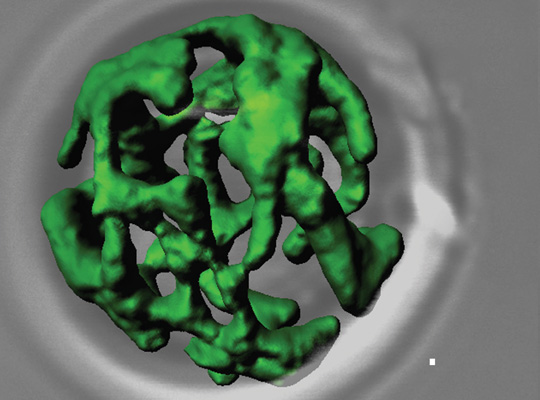Doorway and doorman all in one
Professor Dr. Chris Meisinger of the Excellence Cluster CIBSS – Centre for Integrative Biological Signaling Studies at the University of Freiburg is investigating the protein complex TOM. It selects the proteins permitted to enter the mitochondria - the power-plants of the cell. The proteins selected change, because TOM transforms depending on conditions in the cell, and picks different proteins. Meisinger is particularly interested in the signal pathways responsible for TOM’s transformation. They may play a role in the development of tumors.

Chris Meisinger of the Excellence Cluster CIBSS – Centre for Integrative Biological Signaling Studies is simultaneously spokesman of the newly approved Collaborative Research Center 1381, “Dynamic organization of cellular protein machineries”. Photo: Jürgen Gocke
Mitochondria are present in all cells in the form of organelles. They are separated from the rest of the cell plasma by two membranes. By converting nutrients, they ensure that cells get enough energy for the tasks they perform. To do this, many cell proteins have to enter the mitochondria. Admission is selective – only proteins that have a function in mitochondria are let in. A protein complex called TOM in the outer membrane regulates which proteins are allowed to pass into the mitochondria and which are not. TOM is the doorway and doorman all in one.
For a long time, researchers believed that TOM let any protein pass through at any time. “It was a fixed idea that TOM is always open,” says Chris Meisinger from the Institute of Biochemistry and Molecular Biology at the University of Freiburg. “It was thought that TOM regulates only the amount of the proteins entering.” Now Meisinger has shown that TOM's activity is finely controlled by phosphorylations, small biochemical changes. "Anyone who wants to get past the doorway-doorman-complex needs ID and also has to be in the right place at the right time. In the CIBSS excellence cluster, Meisinger aims to further investigate how phosphorylations regulate TOM's function. The biochemical changes might also play a role in the development of tumors, he says.
Cell energy production demands a lot of coordination
“Researchers have long thought that mitochondria are quite autonomous,” says Meisinger. In the early stages of life on Earth, organelles were probably independent organisms – some kind of bacteria. Today, they are found as compartments in the cells, sealed off by two membranes. Furthermore, mitochondria have their own genome and therefore meet many of the requirements for independence. So why should they exchange more with the rest of the cell than a few metabolic products such as the main energy unit, ATP?
After years of intensive research, scientists discovered that more than 99 percent of all proteins that make up mitochondria do not originate from the organelles themselves. They originate outside, in the cell cytosol. These mitochondrial proteins have an extra line in their “address” – a kind of ID card that TOM recognizes. According to the long-held view of TOM’s function, it opens the door to all proteins that have the right ID. “But about ten years ago, it became clear that protein transport from the cytosol into the mitochondria is coordinated – that there is a lot of communication between cells and mitochondria,” Meisinger says. The way the two co-operate in the production of energy alone requires coordination and signal pathways. Driven by this hypothesis and his gut feeling, Meisinger set to work on the topic – “One of the best decisions of my career.”
The doorway-doorman checks protein ID
Today, Meisinger’s seven-member research group is investigating how phosphorylations affect mitochondrial proteins. Cells can switch many enzymes and other proteins on and off by adding or removing phosphates. So the patterns of these phosphorylations change. The type of phosphorylation pattern of the TOM doorway-doorman complex determines which ID card is the right one. TOM only accepts proteins that have the right identity card at the right time, and rejects all others. However, it is not clear which signaling pathways lead to the phosphorylation of the TOM complex. “Under which conditions do these phosphorylations take place?” Meisinger wonders. “And how do mitochondria give feedback to the cell?”
Meisinger already knows this much: TOM's phosphorylation pattern varies strongly according to the supply of food. “This guarantees that mitochondria can optimally supply the cells with energy at any time." Energy requirements therefore also have a major influence. When cells divide, for example, they need a lot of energy in the form of ATP. Shortly before division, many proteins that are important for the production of ATP are released by TOM into the mitochondria. Meisinger's team has made groundbreaking discoveries on this mechanism.
These could help fight tumors at some point. Back in the last century, the biochemist Otto Heinrich Warburg discovered that tumors often produce energy by glycolysis – the degradation of simple sugars - in the cytosol instead of in the mitochondria. “Tumor cells often switch from respiratory energy production to glycolytic energy production,” Meisinger says. It’s now called the Warburg effect. Nobody really knows exactly how tumors make use of it. Normal cells only take the glycolytic or anaerobic route when they run out of oxygen.

Networklike structure of mitochondria (green) from the model organism bakers' yeast. Source: Research group Meisinger
Could we pull the plug on cancer cells?
It is this very difference between tumor cells and normal cells that might prove useful. When the Warburg effect starts, the phosphorylation pattern of TOM changes. “TOM flips the switch from respiratory to glycolytic," says Meisinger, explaining his latest findings. Might it be possible to inhibit this Warburg phosphorylation, to block the switch – so that tumor cells run out of energy? Or could this mechanism be used to regulate similar processes?
Meisinger’s research currently focuses on understanding the underlying mechanisms. His group is conducting basic research on baker's yeast. The results, he emphasizes, are largely applicable to all eukaryotes – living organisms with cell nuclei – including humans. “Yeast research has probably already won more Nobel prizes than work with human cells.” He is pleased that he has opened up an exciting field of research in the signaling processes involving mitochondria. Experts now know several hundred phosphorylation sites on mitochondrial proteins. Asked about his goals in CIBSS, Meisinger talks about applications. He would like to find targets which could be used to manipulate mitochondrial functions. "For example, the protein that phosphorylates TOM in such a way that the Warburg effect is triggered in tumors,” he says.
Meisinger began his scientific career studying chemistry and biochemistry at the University of Freiburg. He also received his doctorate here, and completed his habilitation in biochemistry and molecular biology. Three other German universities offered him jobs in 2008, but he decided to stay in his hometown. As spokesman of the newly approved Collaborative Research Center 1381, “Dynamic organization of cellular protein machineries,” he thinks the Freiburg environment is ideal. Chris Meisinger says that he can give his scientific curiosity free rein here. “I hope there will be many more surprising research results in the future.”
